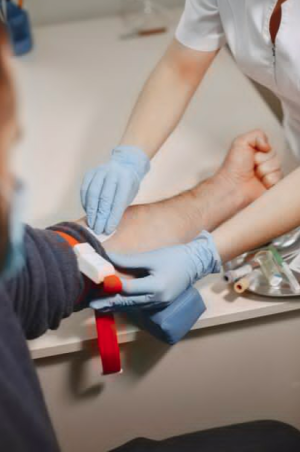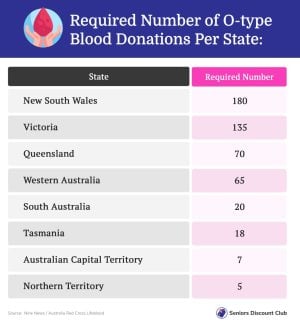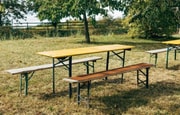Why your blood donation could be crucial in saving lives in Australia right now
By
VanessaC
- Replies 5
As we age, we often come across issues with our health that might require a longer hospital visit. For some, it could involve other procedures, such as a blood transfusion.
And now, with hospitals under increasing pressure and blood stocks reaching critical lows, Lifeblood is urgently appealing for extra donations—and it's our O blood type friends who could make all the difference.
Australian Red Cross Lifeblood has put out an urgent call for 500 Australians with O blood type.
They are encouraged to come forward and make donations daily over the next two weeks, as supplies are at their lowest point in a year.
Those with O-positive and O-negative blood types are in particularly high demand, as these are the universal blood types that are most frequently needed by hospitals.
Stuart Chesneau, Lifeblood’s Executive Director, emphasised that despite more people donating than ever before, the demand for O blood types continues to increase.
'This year, we have seen demand increase by more than three per cent, making it the highest in a decade, and we expect it to continue to grow in the coming years,' Chesneau said.
'To ensure we continue to meet the needs of patients across the country, we need everyone who is eligible—more than 13 million people—to become blood and plasma donors.'
'We also need our existing donors to donate more often.'
'If they could give just one more donation each year, it would make a huge difference, especially to the lives of those who receive it.'
He also explained that O negative is essential as it is used to treat patients whose blood types are unknown. The blood is often stocked in ambulances, and rescue helicopters are used to treat trauma patients who need huge quantities of blood in a short amount of time.
'Fewer than seven per cent of the Australian population is O Negative, making it one of the rarer blood types, however, its versatility means it makes up 16 per cent of the blood ordered by hospitals,' Chesneau added.
'O Positive, meanwhile, is the most common blood type in the community, with 40 per cent of people having this blood type, meaning it’s the type most needed by patients should they require a blood transfusion.'
'Around 50 per cent of people in Australia have type O blood, so if you have one of these blood types there’s a good chance someone in your family will too. We’re asking people to talk to their family members and encourage them to donate,'
Below is a breakdown of the needed blood donations from each state:

Members, have you donated blood before? Share your experience with us in the comments below!
And now, with hospitals under increasing pressure and blood stocks reaching critical lows, Lifeblood is urgently appealing for extra donations—and it's our O blood type friends who could make all the difference.
Australian Red Cross Lifeblood has put out an urgent call for 500 Australians with O blood type.
They are encouraged to come forward and make donations daily over the next two weeks, as supplies are at their lowest point in a year.
Those with O-positive and O-negative blood types are in particularly high demand, as these are the universal blood types that are most frequently needed by hospitals.
Stuart Chesneau, Lifeblood’s Executive Director, emphasised that despite more people donating than ever before, the demand for O blood types continues to increase.
'This year, we have seen demand increase by more than three per cent, making it the highest in a decade, and we expect it to continue to grow in the coming years,' Chesneau said.
'To ensure we continue to meet the needs of patients across the country, we need everyone who is eligible—more than 13 million people—to become blood and plasma donors.'
'We also need our existing donors to donate more often.'
'If they could give just one more donation each year, it would make a huge difference, especially to the lives of those who receive it.'
He also explained that O negative is essential as it is used to treat patients whose blood types are unknown. The blood is often stocked in ambulances, and rescue helicopters are used to treat trauma patients who need huge quantities of blood in a short amount of time.
'Fewer than seven per cent of the Australian population is O Negative, making it one of the rarer blood types, however, its versatility means it makes up 16 per cent of the blood ordered by hospitals,' Chesneau added.
'O Positive, meanwhile, is the most common blood type in the community, with 40 per cent of people having this blood type, meaning it’s the type most needed by patients should they require a blood transfusion.'
'Around 50 per cent of people in Australia have type O blood, so if you have one of these blood types there’s a good chance someone in your family will too. We’re asking people to talk to their family members and encourage them to donate,'
Below is a breakdown of the needed blood donations from each state:
Key Takeaways
- Australian Red Cross Lifeblood urgently needs an extra 500 Australians with O blood type to donate daily as their supplies have reached the lowest point in a year.
- Demand for blood has increased by over 3 per cent this year, making it the highest in a decade, according to Stuart Chesneau, the Lifeblood Executive Director.
- If existing donors could contribute just one more donation annually, it could have a significant impact, especially on the lives of those who receive it.
- A breakdown of each state's requirement for O-type blood donations was provided, with New South Wales needing the most at 180.
Last edited:









